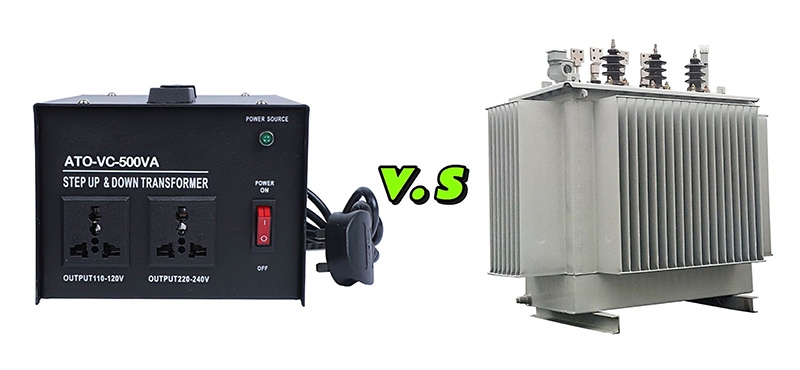In everyday life and industrial settings, it’s common to encounter scenarios where voltage adjustment is necessary to make devices compatible. Many confuse "voltage converters" and "transformers," believing they are the same. However, while both are related to voltage adjustment, they differ significantly in principle, structure, usage, and application scope. This blog explores the fundamental definitions, working principles, key differences, and practical applications of voltage converters and transformers to help you better understand and select the appropriate device.
Basic Definitions of Voltage Converters and Transformers
- What is a Voltage Converter?
A voltage converter is a device that adjusts voltage from one level to another, typically categorized into step-up and step-down converters. It is primarily used to adapt electronic devices or appliances, particularly when traveling between countries with different voltage standards, such as converting 220V to 110V or vice versa. Voltage converters are generally based on electronic circuits, employing semiconductor components like diodes, transistors, and switching power supply technology to regulate voltage.
- What is a Transformer?
A transformer is a device that changes voltage levels using the principle of electromagnetic induction. It typically consists of primary and secondary coils and an iron core. Transformers work by electromagnetic coupling to adjust AC voltage levels, but cannot handle DC voltage conversion. Transformers are commonly used in power transmission systems, such as stepping down high voltage from power plants for household use or providinga suitable voltage in electronic devices.

Working Principles of Voltage Converters and Transformers
- Working Principle of Voltage Converters
The core principle of a voltage converter involves regulating voltage via electronic circuits. Depending on the type, converters are classified as:
Switching Power Supply Converters: These use high-speed switching transistors to convert input voltage into high-frequency pulsed voltage, then rectified and filtered to achieve the desired output voltage.
Linear Voltage Regulators: These adjust the working state of electronic components to linearly step down the input voltage to the target level, offering stable output but lower efficiency.
Characteristics: Voltage converters are suitable for household appliances and small electronic devices and work with AC and DC power sources.
- Working Principle of Transformers
Transformers operate based on the law of electromagnetic induction: when an AC flows through the primary coil, it generates a magnetic field in the core, inducing a voltage in the secondary coil. Voltage is adjusted based on the coil turn ratio:
Step-Up Transformer: The secondary coil has more turns than the primary, resulting in a higher output voltage than the input.
Step-Down Transformer: The secondary coil has fewer turns, producing a lower output voltage than the input.
Characteristics: Transformers apply only to AC power sources and are widely used in high-power transmission and electrical grids.
Key Differences Between Voltage Converters and Transformers
To clearly understand the differences, the following table summarizes the distinctions across various dimensions:
| Comparision Aspect | Voltage Converter | Transformer |
| Working Principle | Uses electronic circuits for voltage regulation, e.g., switching power supply technology | Based on electromagnetic induction, uses coils and an iron core coupling |
| Applicable Power Source | Supports both AC and DC power sources | Only suitable for AC power sources |
| Efficiency | Efficiency varies by type (switching power converters are more efficient) | Higher efficiency, but has some energy losses |
| Output Voltage | The output voltage can be a stable DC or AC voltage | The output voltage is generally AC, not suitable for DC conversion |
| Application | Small electronic devices, international travel appliances, and low-power applications | Power transmission, industrial grids, high-power devices |
| Structure and Weight | Usually lightweight and portable | Larger structure, heavier, suitable for fixed installation |
| Cost | Lower cost depending on technology type | Higher cost, especially for high-power transformers |
Application Scenarios of Voltage Converters and Transformers
- Application Scenarios of Voltage Converters
International Travel: Voltage standards differ between countries (e.g., 220V in China, 110V in the US), requiring voltage converters for electrical appliances.
Electronic Device Power Supply: Provides stable voltage for laptops, phone chargers, etc.
Household Appliance Adaptation: Adjusts imported appliance voltage to local standards.
Example: A traveler from China to the US must convert 220V to 110V to use a hairdryer or electric razor, making a voltage converter essential.
- Application Scenarios of Transformers
Power Transmission: Used in power grids to step up voltage for long-distance transmission or step down voltage for household use.
Industrial Applications: Provides suitable voltage for large equipment like production line machines or welding equipment.
Internal Components of Electronics: Includes step-down transformers in power adapters.
Example: Household power typically runs at 220V, but a mobile charger transformer reduces this to around 5V DC.
How to Choose Between Voltage Converters and Transformers?
- Based on Power Source Type: If using AC power and needing voltage adjustment, choose a transformer. For conversions between AC and DC or to stabilize voltage, opt for a voltage converter.
- Based on Power Demand: Transformers are suitable for high-power appliances like industrial machines or power grids. Voltage converters are ideal for small electronic devices like phones or laptops.
- Based on Portability: Voltage converters are compact and lightweight, making them suitable for travel. Transformers are bulky and heavier, better suited for fixed installations.
- Based on Safety and Stability: Choose voltage converters with overvoltage, overcurrent, and overheating protection. For transformers, ensure high-quality products, especially in industrial or grid applications.
Conclusion
While voltage converters and transformers can both achieve voltage conversion, they differ significantly in working principles, application scenarios, and input/output power types. Voltage converters are better suited for low-power electronic devices, commonly used during travel, and support both AC and DC conversions. Transformers are primarily used for AC voltage adjustments, and they are ideal for power transmission and industrial use.
When selecting a device, consider specific needs, power requirements, power source type, and usage scenarios to ensure the safe and efficient operation of electrical equipment. If you have further questions, feel free to contact us for additional guidance!
